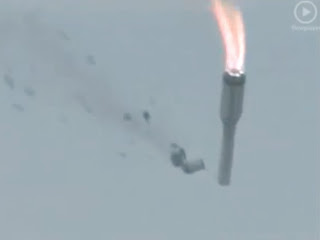 |
| The CASSIOPE satellite towering over Canadian Space Agency (CSA) astronaut Jeremy Hansen in 2009. According to the caption on the CSA webpage, the satellite was then scheduled for launch in 2010. Photo c/o CSA. |
Much like another industrial age icon, the railroads which never seemed to run on time, the typical modern day rocket launch is almost always behind schedule.
Recent Canadian examples of this include the Cascade Smallsat and Ionospheric Polar Explorer (CASSIOPE) small satellite, currently scheduled for a September 5th, 2013 launch and two UrtheCast high definition cameras originally set for a October 16th, 2013 launch to the International Space Station (ISS), but now postponed until at least November.
 |
| Steve Bochinger. |
In fact, anyone with even a cursory interest in tracking the "Worldwide Launch Schedule" updates on the SpaceFlight Now website would normally notice more launch delays than launch dates.
And according to Euroconsult chief operating officer Steve Bochinger, there is very little which can be done to improve the situation, at least over the short term. "When you include all categories of launch vehicles, such as those required for large geostationary telecommunications satellites, the total market is clearly under-supplied," said Bochinger in a recent phone interview.
 |
| An image of the July 1st, 2013 Proton-M launch just seconds before it crashed. According to the July 10th, 2013 Space Safety article "Proton Launch Failure Update: Culprit Found," investigators believe the crash occurred because the angular velocity sensors in the first stage were installed upside down. Photo c/o Roscosmos. |
And by "under-supplied," Bochinger means that there is simply not enough reliable rockets to go around.
Recent launch failures such as the February 1st, 2013 Sea Launch mission to launch the Intelesat 27 satellite (which fell into the Pacific Ocean fifty-six seconds after launch as described on the Russian Space Web) and concerns over the July 1st, 2013 failure of the workhorse Russian Proton rocket are further constricting the market.
So while some of the more successful launch providers, such as the French based Arianespace (with over 50 consecutive Ariane 5 launches completed since 2002) are certainly benefiting, most satellite operators and providers are scrambling to find rides in the current tight market, which is generally anticipated to remain "under-supplied" for at least a few more years.
 |
| The SpaceX Falcon family of rockets. The expected September 5th, 2013 launch of the Canadian CASSIOPE satellite aboard a Falcon-9 will be the first use of the upgraded Merlin 1D engines, expected to generate approximately 56 percent more sea-level thrust than the Merlin 1C engines used on all previous Falcon 9 vehicles. |
As outlined in the May 29th 2012, Space-X press release "INTELSAT signs first commercial Falcon Heavy Launch Agreement with SpaceX," the new system will be designed to meet "both NASA human rating standards as well as the stringent US Air Force requirements for the Evolved Expendable Launch Vehicle (EELV) program, making it an attractive solution for commercial, civil and military customers."
But SpaceX isn't going to be the only new player on the block over the next few years. As outlined in the June 20th, 2013 China Daily article "China seeks to boost share of satellite market," the Chinese will be rolling out the next generation of Long March 5 heavy lift rockets in 2015 as the first step in an effort to expand their share of the international launch market to 15% by 2020. Since 2005, China has launched satellites for Nigeria, Venezuela, Pakistan, Turkey, Argentina and Ecuador.
India is also continuing with the development of its troubled Geosynchronous Satellite Launch Vehicle (GSLV) as outlined in the July 23rd, 2013 NBC News story "India plans to launch first Mars mission, test large rocket this year."
But perhaps the biggest potential launch breakthrough is Stratolaunch Systems, with its plans for huge carrier aircraft capable of launching large multi-stage boosters into a variety of orbits. Founded in 2011 by Microsoft co-founder Paul G. Allen and Scaled Composites founder Burt Rutan (who had previously collaborated on the creation of Ansarii X-Prize winner SpaceShipOne), the new system is scheduled (even if not altogether expected) to roll-out in 2015.
Stand by for adventure when these new systems roll out as the satellite markets react to the expanded capacity.

No comments:
Post a Comment